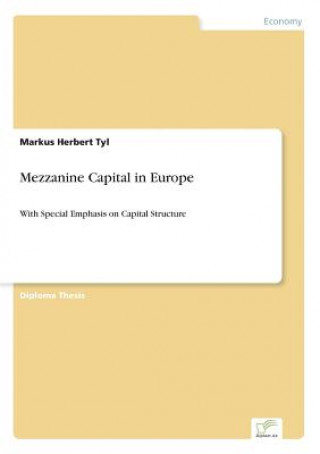
Livrare
Consilier de cumpărături





Nu se pretează? Nu contează! La noi puteți returna bunurile în 30 de zile
 Voucher cadou
orice valoare
Voucher cadou
orice valoare
Cu un voucher cadou nu veți da greș. În schimbul voucherului, destinatarul își poate alege orice din oferta noastră.
Mezzanine Capital in Europe
 engleză
engleză
 261 b
261 b
30 de zile pentru retur bunuri
Ar putea de asemenea, să te intereseze


Diploma Thesis from the year 2002 in the subject Business economics - Investment and Finance, grade: 1,0, University of Vienna (Sozial- und Wirtschaftswissenschaften), language: English, abstract: Inhaltsangabe:Abstract:§In corporate finance two major decisions have to be made. One is the investment decision which means companies must decide which available opportunities they should invest in. The other one, the financing decision, also known as the capital structure decision, tries to answer the question of from where the money to finance investment projects should come.§Money can either be raised internally, through retained earnings, or externally. Mezzanine capital, as a special type of external finance, therefore falls into the area of the financing decision.§Although the use of mezzanine capital has increased in Europe in recent years, this special type of finance is still relatively unknown in some countries. Therefore, the purpose of my thesis is to familiarise the reader with this particular type of finance. It is structured in a way that it sequentially deals with the following questions:§How did mezzanine develop?§Can it offer an advantage compared to financing only with debt and equity?§Which basic types of mezzanine instruments exist and how are they valued?§When and where is mezzanine used?§At the end, an example of a management buy-out in which mezzanine is used is provided. This will give important insights into the practical use of multiples to structure the deal, the mezzanine investment process, the investment criteria and the various exit routes that exist.§The paper will be concluded with an overview on the European mezzanine landscape and on how recent stock market developments and the new Basel capital accord (Basel II) may impact the future of mezzanine capital.§Special terminology or important information that is used in the private equity area is written in bold letters if mentioned for the first time in the text.§The issue of a convertible promissory note to raise funds to build a canal in the UK is believed to be the first mezzanine instrument. It was issued in 1798 by the Company of proprietors to the Canal Navigation from Manchester to or near Ashton-under-Lyne and Oldham .§However, the idea of converting debt into equity was already used after the War of Spanish Succession when in 1711 the British government had a heavy debt burden. As the debt was trading at a substantial discount it made the refinancing more difficult. A solution was found in creating a new body, the South Sea Company , whose newly issued shares were to be swapped for Pds. 9.5m of floating debt - thereby reducing the interest payments by three percent per annum.§In the 1980s a high rate of new product innovation, especially in financial markets, could be observed. Among the products innovated or revived during that decade were swaps, index options, mortgage bonds and mezzanine finance. The following reasons led to the particularly strong product development in the corporate finance market:§Deregulation of the domestic financial markets in the major OECD countries.§The lifting of controls over the flows of external capital movements in many countries.§Liberalisation towards the internationalisation of securities markets and merger and acquisition (M&A) activity.§Global monetary conditions with low interest rates and a revival of economic and corporate activity.§The above stated reasons in turn led to increased competition and the establishment of large financial conglomerates which mainly used tailor-made financial services to differentiate their products from those of competitors and also to fulfil their clients desires.§After the equity market crash in October 1987 the monetary banks of the largest economies, fearing a financial recession, reduced interest rates even further. Investments...
Informații despre carte
 engleză
engleză




 Cum să cumpăr
Cum să cumpăr






















